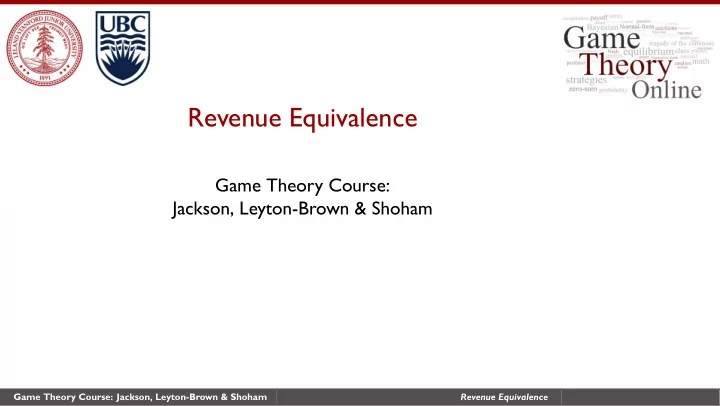

Revenue Equivalence Game Theory Course: Jackson, Leyton-Brown & Shoham Game Theory Course: Jackson, Leyton-Brown & Shoham Revenue Equivalence .
. Revenue Equivalence • Which auction should an auctioneer choose? To some extent, it doesn’t matter... . Theorem (Revenue Equivalence Theorem) . Assume that each of n risk-neutral agents has an independent private valuation for a single good at auction, drawn from a common cumulative distribution F ( v ) . Then any two auction mechanisms in which • in equilibrium, the good is always allocated in the same way; and • any agent with valuation v has an expected utility of zero; both yield the same expected revenue, and both result in any bidder with valuation v making the same expected payment. . Game Theory Course: Jackson, Leyton-Brown & Shoham Revenue Equivalence .
Thus in a second-price auction, the seller’s expected revenue is First and second-price auctions satisfy the requirements of the revenue equivalence theorem every symmetric game has a symmetric equilibrium in a symmetric equilibrium of this auction game, higher bid higher valuation . First and Second-Price Auctions • The k th order statistic of a distribution: the expected value of the k th -largest of n draws. • For n IID draws from [0 , v max ] , the k th order statistic is n + 1 − k v max . n + 1 Game Theory Course: Jackson, Leyton-Brown & Shoham Revenue Equivalence .
First and second-price auctions satisfy the requirements of the revenue equivalence theorem every symmetric game has a symmetric equilibrium in a symmetric equilibrium of this auction game, higher bid higher valuation . First and Second-Price Auctions • The k th order statistic of a distribution: the expected value of the k th -largest of n draws. • For n IID draws from [0 , v max ] , the k th order statistic is n + 1 − k v max . n + 1 • Thus in a second-price auction, the seller’s expected revenue is n − 1 n + 1 v max . Game Theory Course: Jackson, Leyton-Brown & Shoham Revenue Equivalence .
. First and Second-Price Auctions • The k th order statistic of a distribution: the expected value of the k th -largest of n draws. • For n IID draws from [0 , v max ] , the k th order statistic is n + 1 − k v max . n + 1 • Thus in a second-price auction, the seller’s expected revenue is n − 1 n + 1 v max . • First and second-price auctions satisfy the requirements of the revenue equivalence theorem • every symmetric game has a symmetric equilibrium • in a symmetric equilibrium of this auction game, higher bid ⇔ higher valuation Game Theory Course: Jackson, Leyton-Brown & Shoham Revenue Equivalence .
. Applying Revenue Equivalence • Thus, a bidder in a FPA must bid his expected payment conditional on being the winner of a second-price auction • this conditioning will be correct if he does win the FPA; otherwise, his bid doesn’t matter anyway • if v i is the high value, there are then n − 1 other values drawn from the uniform distribution on [0 , v i ] • thus, the expected value of the second-highest bid is the first-order statistic of n − 1 draws from [0 , v i ] : n + 1 − k v max = ( n − 1) + 1 − (1) ( v i ) = n − 1 v i n + 1 ( n − 1) + 1 n • This shows how we derived our earlier claim about n -bidder first-price auctions. Game Theory Course: Jackson, Leyton-Brown & Shoham Revenue Equivalence .
Recommend
More recommend